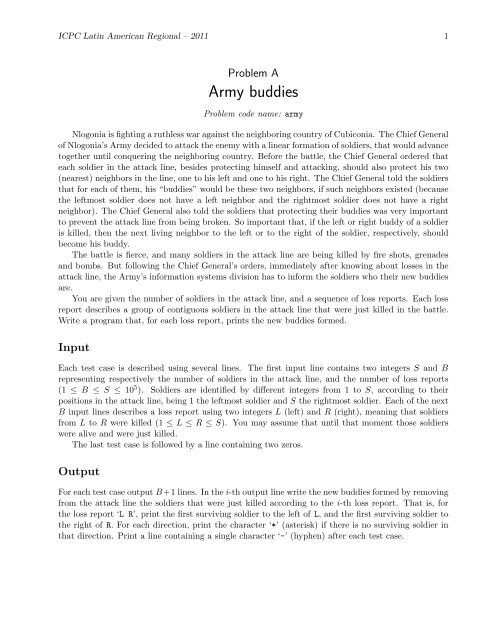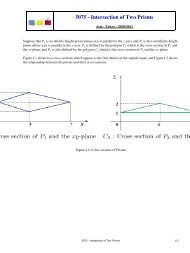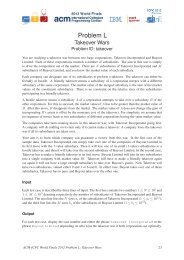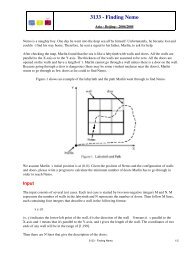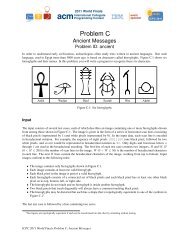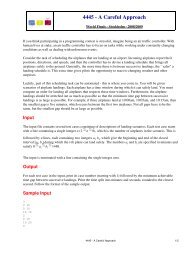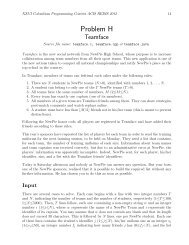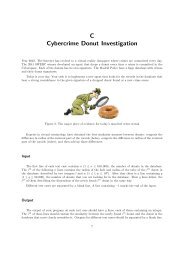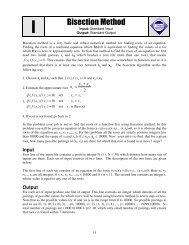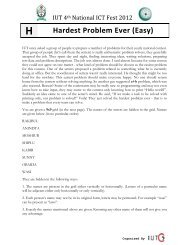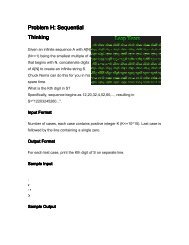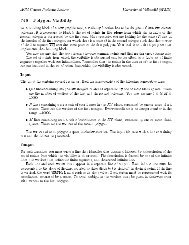Army buddies - UVa Online Judge
Army buddies - UVa Online Judge
Army buddies - UVa Online Judge
Create successful ePaper yourself
Turn your PDF publications into a flip-book with our unique Google optimized e-Paper software.
ICPC Latin American Regional – 2011 1<br />
Problem A<br />
<strong>Army</strong> <strong>buddies</strong><br />
Problem code name: army<br />
Nlogonia is fighting a ruthless war against the neighboring country of Cubiconia. The Chief General<br />
of Nlogonia’s <strong>Army</strong> decided to attack the enemy with a linear formation of soldiers, that would advance<br />
together until conquering the neighboring country. Before the battle, the Chief General ordered that<br />
each soldier in the attack line, besides protecting himself and attacking, should also protect his two<br />
(nearest) neighbors in the line, one to his left and one to his right. The Chief General told the soldiers<br />
that for each of them, his “<strong>buddies</strong>” would be these two neighbors, if such neighbors existed (because<br />
the leftmost soldier does not have a left neighbor and the rightmost soldier does not have a right<br />
neighbor). The Chief General also told the soldiers that protecting their <strong>buddies</strong> was very important<br />
to prevent the attack line from being broken. So important that, if the left or right buddy of a soldier<br />
is killed, then the next living neighbor to the left or to the right of the soldier, respectively, should<br />
become his buddy.<br />
The battle is fierce, and many soldiers in the attack line are being killed by fire shots, grenades<br />
and bombs. But following the Chief General’s orders, immediately after knowing about losses in the<br />
attack line, the <strong>Army</strong>’s information systems division has to inform the soldiers who their new <strong>buddies</strong><br />
are.<br />
You are given the number of soldiers in the attack line, and a sequence of loss reports. Each loss<br />
report describes a group of contiguous soldiers in the attack line that were just killed in the battle.<br />
Write a program that, for each loss report, prints the new <strong>buddies</strong> formed.<br />
Input<br />
Each test case is described using several lines. The first input line contains two integers S and B<br />
representing respectively the number of soldiers in the attack line, and the number of loss reports<br />
(1 ≤ B ≤ S ≤ 10 5 ). Soldiers are identified by different integers from 1 to S, according to their<br />
positions in the attack line, being 1 the leftmost soldier and S the rightmost soldier. Each of the next<br />
B input lines describes a loss report using two integers L (left) and R (right), meaning that soldiers<br />
from L to R were killed (1 ≤ L ≤ R ≤ S). You may assume that until that moment those soldiers<br />
were alive and were just killed.<br />
The last test case is followed by a line containing two zeros.<br />
Output<br />
For each test case output B +1 lines. In the i-th output line write the new <strong>buddies</strong> formed by removing<br />
from the attack line the soldiers that were just killed according to the i-th loss report. That is, for<br />
the loss report ‘L R’, print the first surviving soldier to the left of L, and the first surviving soldier to<br />
the right of R. For each direction, print the character ‘*’ (asterisk) if there is no surviving soldier in<br />
that direction. Print a line containing a single character ‘-’ (hyphen) after each test case.
ICPC Latin American Regional – 2011 2<br />
Sample input<br />
1 1<br />
1 1<br />
10 4<br />
2 5<br />
6 9<br />
1 1<br />
10 10<br />
5 1<br />
1 1<br />
0 0<br />
Output for the sample input<br />
* *<br />
-<br />
1 6<br />
1 10<br />
* 10<br />
* *<br />
-<br />
* 2<br />
-


